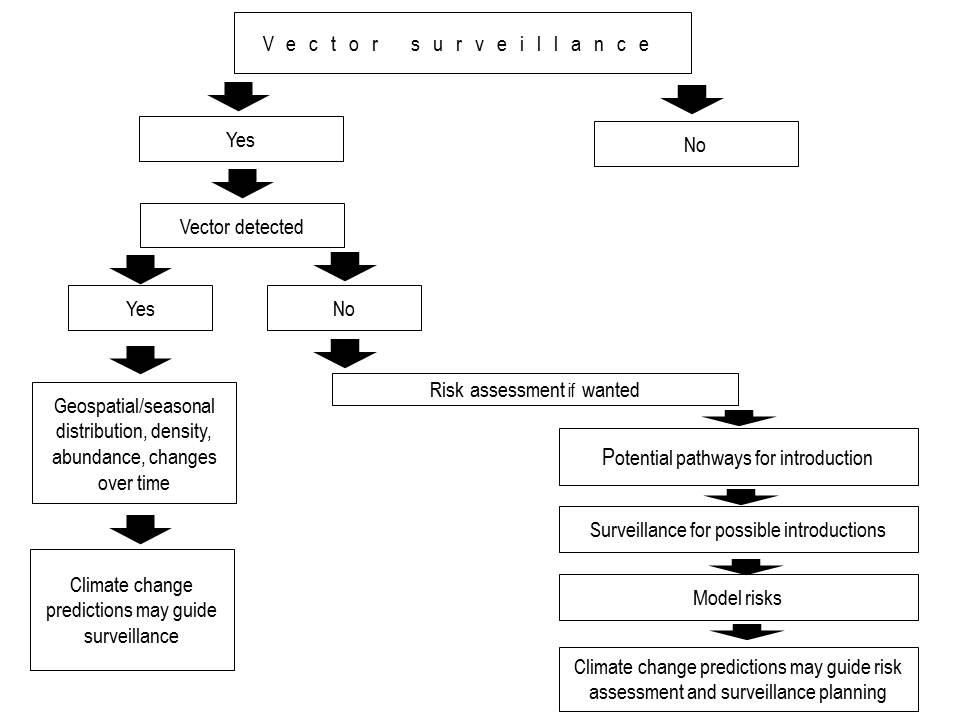Terrestrial Animal Health Code
Terrestrial Animal Health Code |
Surveillance for arthropod vectors of animal diseases
Introduction
Vector-borne diseases are of increasing importance economically and to human and animal health.
Environmental (including climate change), sociological and economical changes may affect the distribution and impact of these diseases.
Improved understanding of the distribution and population dynamics of the vectors is a key element for assessing and managing the risks associated with vector-borne animal and zoonotic diseases.
The Terrestrial Code contains recommendations for the surveillance of several vector-borne diseases and general recommendations for animal health surveillance.
The need has arisen to complement these general recommendations on surveillance with advice on the surveillance for vectors themselves. This chapter only addresses surveillance for arthropod vectors.
For the purpose of trade, it should be noted that there is no conclusive relationship between the presence of vectors and the disease status of a country/zone, and also that the apparent absence of vectors does not by itself confirm vector-free status.
A decision tree for vectorsurveillance is presented in Figure 1.
Objectives
The objective of these recommendations is to provide methods for:
gathering up-to-date information on the spatial and temporal distribution and abundance of vectors of the arthropod-borne listed diseases and emerging diseases;
monitoring changes in the spatial and temporal distribution and abundance of these vectors;
collecting relevant data to inform risk assessment (including vector competency) and risk management of these vector-borne diseases;
detecting the presence of specific vectors or confirming their absence;
understanding pathways of entry for vectors and vector-borne pathogenic agents.
Sampling methodology
Sampling plan
The objective of the surveillance programme should be determined and stated before planning begins.
Available historical data on the vector or the disease for the country or zone should be collated and assessed.
The sampling plan should consider the following:
the biology and ecology of the vectors,
the presence, distribution and abundance of the vectors’ host animal populations,
the environmental, climatic, ecological and topographic conditions of relevance to vector ecology,
the need for a risk assessment to indicate the areas at highest risk of introduction of a vector that is unlikely to be present.
Sampling should be aimed at:
establishing vector presence or confirming vector absence in the country or zone,
describing the distribution of the vectors within the country or zone,
providing additional information on vector density and spatial/temporal variability (both over the short and the long-term),
early detection of vectors or vector-borne pathogenic agents in areas with risks of entry and establishment.
The sampling plan should be designed to provide appropriate estimates of the indicators listed above. Consideration should be given to the following:
The recommended general approach to sampling is via a three-stage hierarchy:
stratification based on ecological criteria (where possible), and risk assessment for vector introduction,
subdivision of strata into spatial sampling units, and
establishment of actual sampling sites within selected spatial sampling units.
If adequate entomological, epidemiological and historical data and/or expert opinion exists, the sampling plan may be refined or targeted by defining strata which are as homogeneous as possible with respect to the following known or suspected risk-factors, as appropriate for the country or zone:
domestic or wild populations of host animals preferred by the vector,
vector habitat suitability,
climatic patterns (including seasonal),
areas endemically and/or epidemically affected by the diseases of concern,
areas of known vector occurrences,
fringe zones around areas of known vector occurrences or other high risks areas for vector introduction, such as ports,
areas in which the diseases or vectors of concern have not been reported currently or historically,
each stratum (or the whole country or zone, if not stratified) should be divided into spatial sampling units in accordance with standard methodologies such as a grid system,
the number and size of the spatial sampling units should be defined to provide appropriate estimates of the indicators listed above,
the number and location of actual sampling sites within each spatial sampling unit also should be defined to provide appropriate estimates of the indicators listed above,
different levels of sampling intensity (spatial sampling unit size, number of units sampled, number of sites sampled within units, and sampling frequency) may be applied to different strata into which the country or zone has been divided. For example, more intensive sampling might be carried out in strata where vector presence seems most likely, based on biological or statistical criteria.
Sampling methods
Many sampling methods have been developed for the capture of vector arthropods, and these differ in accordance with the disease/vector system under consideration.
The collection methods used should be adapted as required to ensure reasonable confidence of collecting the vectors of concern.
Collection methods should obtain the various developmental stages (such as eggs, larvae, nymphs, adults) and adult age categories, as appropriate to the species in question and the objectives of the surveillance. For example, if a vector is not believed to be present, collection methods should target the developmental stages most likely to be introduced, or that are most readily detected. If the vector is present, life stages required to estimate population survival rates and population dynamics in relation to disease transmission should be collected.
Different collection methods may be required to obtain samples from a single vector species, depending on the life stage or place of capture (such as from the environment or from the host animals). The collection method should be appropriate to the species and life stage of interest.
The collection methods should preserve the vectors in a manner suitable for their morphological identification or identification with molecular techniques. Where the purpose of sampling is to detect or isolate pathogenic agents, specific protocols should be followed to ensure the samples are suitable for these assays.
Data management, analysis and interpretation
Data management and analytical methodologies should be done in accordance with Chapter 1.4.
Fig. 1. Decision tree for vector surveillance

nb: first adopted in 2009; most recent update adopted in 2010.
2024 ©OIE - Terrestrial Animal Health Code |